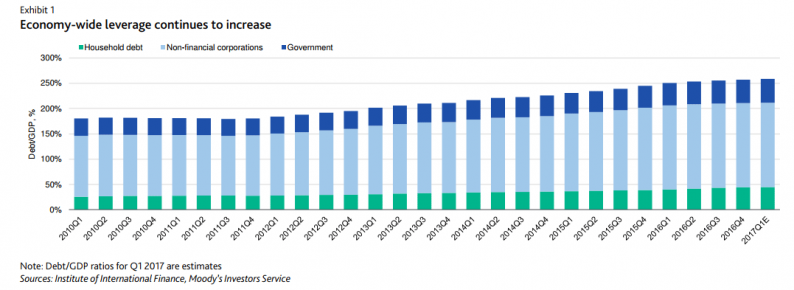A July 15 meeting of China’s National Financial Work Conference, with Chinese GDP growth slowing and the country under criticism for its leverage management practices, put on display “a refreshed commitment to vigilance to financial risks and reforms to curb leverage,” a Moody’s report said. The encouragement is a change from analysis earlier in the year from the ratings agency. The positivity of that five-year high-level planning meeting might be spreading, as the International Monetary Fund recently characterized China’s debt as “moderate,” pointing to reform efforts.

Leverage has been used to fuel historic Chinese GDP Growth
The policy objectives China’s financial leaders envision for the world’s most populous nation exhibited a “wide-ranging commitment to deleveraging, financial stability,” Moody’s noted, with varying credit issues that come into play.
Chinese authorities are now giving an equal weighting to deleveraging and growth even as leverage continues to rise. Growth and leverage have been the elixir that led the nation from near $1.2 trillion (USD) in gross domestic product in 2000 to increase by nearly tenfold, to $11.2 trillion in 2016, vaulting past India’s $2.264 trillion and approaching the US GDP of $18.7 trillion. Chinese GDP growth peaked in 2007 at 14.2% at a time the US, in the middle of a highly leveraged housing boom, only managed 1.8% GDP growth. Chinese GDP growth has since slowed to 6.7%.
“China’s growth model has relied on credit-funded investment, especially in infrastructure,” Moody’s noted. China was in part criticized for using leverage to build numerous “ghost cities” that stood idle and bridges that led to nowhere in an effort to spur an economic renaissance.
China’s ascent on the world stage has resulted, with its role in becoming part of the IMF SDR currency basket one of several major milestones. A more recent benchmark may be longtime US ally Saudi Arabia recently announcing that it would be willing to finance its debt using the Chinese yuan, breaking a petrodollar relationship with the US that has been a key strategic objective in the region.













Leave A Comment